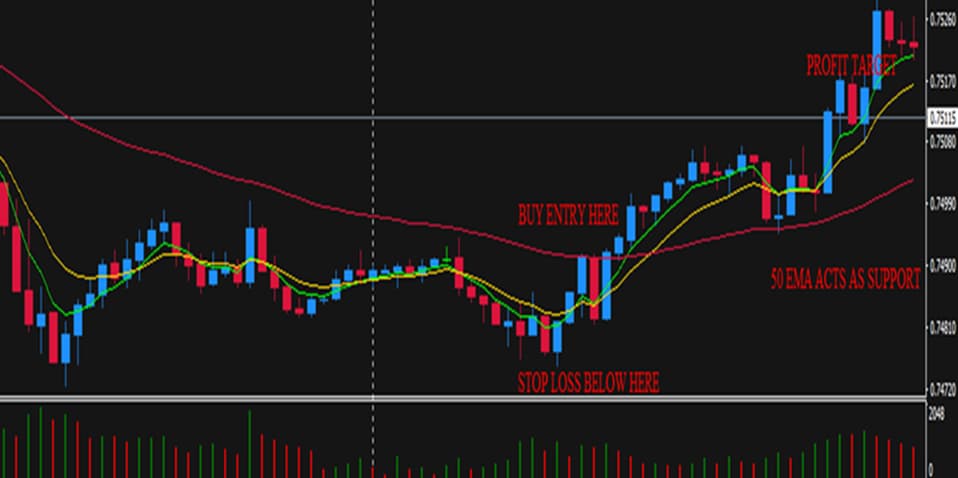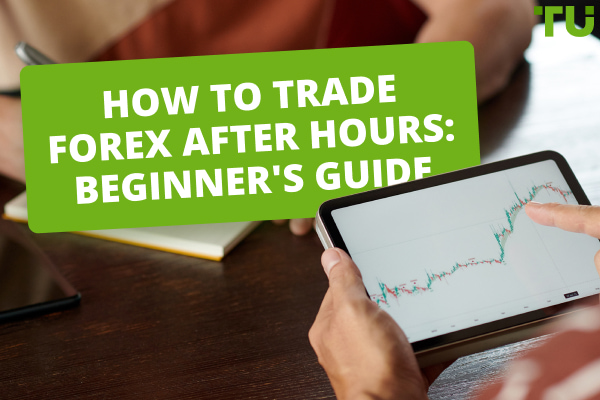What Is The Simple Forex Day Trading Strategy
The dance strategy is an easy to use forex trading strategy designed for day trading. One of the best things about this strategy is that you can often find, open, and profitably close a trade – with a nice profit for the day – in less than an hour or two.
Sometimes, the simplest things, those that can be worked in the easiest way, turn out to also be the things that work out the best. And that’s just as true for trading strategies as it is for anything else in life.
I’ve seen some technical trading strategies that had so many technical indicators loaded onto a chart that you could hardly see where the price was. In contrast, this strategy uses just one type of technical indicator – the moving average – and a total of three reference lines on a chart (all three are moving averages).
Do you want to start trading Forex? Open an account on Roboforex!The Simple Forex Day Trading Strategy
Course for Beginners Traders by TU
The origin of the dance strategy
I learned this forex strategy from a fellow trader more than 15 years ago. (If you’ve read elsewhere that it is the creation of a Chinese sorcerer who lived in the 12th century, and has been a closely guarded trading secret employed by masters of Shaolin kung fu…well, that’s just not true.)
This strategy has been a key part of my trading arsenal ever since I learned it. It is also still the day trading strategy that I have used most often over the years in trading the forex market.
The Dance strategy has its origin in the observation by its creator that many technical indicators that are commonly used in forex trading often tend to be a kind of self-fulfilling prophecy. This includes indicators such as Fibonacci retracement lines and moving averages. Trading off of support and resistance levels that are identified using such popular indicators often works out well – makes for profitable trading - simply because of the fact that there are millions of forex traders out there who use these indicators.
So, while there might not be anything magical or objectively significant about whatever price level coincides with, for example, the 20-period moving average, placing a trade at that level may work out all right just because the buying or selling pressure created by the orders entered at that price level by millions of forex traders around the world may be sufficient enough to move price in the direction they all desire.
While no indicator is foolproof, guaranteed to generate profits, trading with technical indicators that are likely to have hundreds of thousands of other traders backing your play can provide you with at least a slight trading edge. Having an edge in trading, even just a small one, is frequently the difference that distinguishes traders who are consistently profitable from those who are not.
The Dance strategy relies on perhaps the single most widely used technical indicator – the moving average.
Best Forex brokers

The dance trading strategy
Without further ado, here is how the Dance trading strategy works.
This strategy is traded off of the 15-minute price chart. The three moving averages to be plotted on the chart are the 5-period moving average, the 10-period moving average, and the 50-period moving average. Personally, I use exponential moving averages (EMAs), which respond more quickly to the most recent price changes. You’re free to use simple moving averages (SMAs) if you wish. I know a number of traders who do implement this strategy using SMAs. I have the averages calculated based on the closing price of each time period. An alternative is to have the averages calculated based on the average price of each time period.
A buy signal is generated as follows:
-
After the market price has been trading below the 50-period EMA, a 15-minute candle closes above the 50-period EMA
-
The 5-period EMA is above the 10-period EMA
-
A stronger buy signal is generated if both the 5-period and 10-period EMAs have crossed from below to above the 50-period EMA
-
An alternative entry point is to wait for all of the above conditions to be met and then for price to have retraced back to close to the 50-period EMA
-
An initial stop-loss order should be placed just below the most recent swing low occurring prior to the buy signal being generated
Short selling signals are generated likewise, just in the opposite direction – e.g., by price and the moving averages move from above the 50 EMA to below it.
The following chart of action in AUD/USD illustrates how all of this plays out (the dark maroon line is the 50 EMA, the green line is the 5 EMA, and the yellow line is the 10 EMA):

Chart of action in AUD/USD
A buy entry is indicated when a 15-minute candle closes just above the 50 EMA, around .7490. A stop-loss order can be placed just below the low of the big down candle that immediately preceded the large up candlestick that provides the buy signal. Note that the stop-loss price level is below the potential support levels provided by the 5 EMA and 10 EMA.
After the buy signal was generated, the price moved steadily higher, up to approximately .7505. That gave a trader an opportunity to take a 10-15 pip profit in less than two hours. An alternative option, if a trader’s analysis led them to believe that price could advance significantly higher – which, in this case, it did – would be to move the stop-loss up to a price level of breakeven or a little better. A second alternative would be to take profits on half of one’s position, and let the other half ride with the stop-loss moved up.
Note that as price moved higher, with the exception of the one time that it retraced to the 50 EMA, the 5 and 10 EMAs acted as ongoing price support levels.
Additional notes on the dance strategy
Here are a couple of extra points to keep in mind that can potentially help to increase the strategy’s chances of resulting in profitable trades.
First, this is strictly a short-term, intraday trading strategy. Therefore, traders should look to take at least partial profits fairly quickly. Personally, I have rarely stayed in one of these trades any longer than two or three hours – and have often exited within just half an hour or so.
Second, in order to protect against market reversals, it’s usually a good idea to move up your stop-loss order aggressively. One rule of thumb is to move your stop up to breakeven or better once the trade shows a profit of 10 or more pips.
Third, a strongly recommended trade filter to use is only taking trades that are in the direction of the overall trend in the market, as showing on the daily chart. Prevailing uptrends or downtrends can usually be easily identified with just a glance at the daily chart. Alternatively, uptrends or downtrends can be indicated using major moving averages such as the 20-day moving average or the 50-day moving average.
Finally, a note on using a retracement to the 50 EMA as an alternative trade entry point: This should only be done once. A second retracement to the 50 EMA is much more likely to see the 50 EMA fail as a support level and see the market price moving lower.
Conclusion
One of the primary advantages of the Dance forex trading strategy is that it is a very low-risk strategy. When a trading signal is generated, the initial stop-loss level indicated is typically no more than 10-12 pips from the trade entry price. Thus, the strategy is designed to prevent the kind of large losses that frequently wipe out forex traders.
Another advantage of this strategy is, as mentioned at the outset, its simplicity. It doesn’t require a trader to have extensive expertise in technical trading.
As with any trading strategy, it is recommended that you first try paper trading it in demo mode to see how it plays out and get comfortable using it before risking real money in the market.
Team that worked on the article
Johnathan M. is a U.S.-based writer and investor, a contributor to the Traders Union website. His two primary areas of expertise include finance and investing (specifically, forex and commodity trading) and religion/spirituality/meditation.
His experience includes writing articles for Investopedia.com, being the head writer for the Steve Pomeranz Show, a personal finance radio program on NPR. Johnathan is also an active currency (forex) trader, with over 20 years of investing experience.
Dr. BJ Johnson is a PhD in English Language and an editor with over 15 years of experience. He earned his degree in English Language in the U.S and the UK. In 2020, Dr. Johnson joined the Traders Union team. Since then, he has created over 100 exclusive articles and edited over 300 articles of other authors.
The topics he covers include trading signals, cryptocurrencies, Forex brokers, stock brokers, expert advisors, binary options. He has also worked on the ratings of brokers and many other materials.
Dr. BJ Johnson’s motto: It always seems impossible until it’s done. You can do it.
Mirjan Hipolito is a journalist and news editor at Traders Union. She is an expert crypto writer with five years of experience in the financial markets. Her specialties are daily market news, price predictions, and Initial Coin Offerings (ICO). Mirjan is a cryptocurrency and stock trader. This deep understanding of the finance sector allows her to create informative and engaging content that helps readers easily navigate the complexities of the crypto world.










